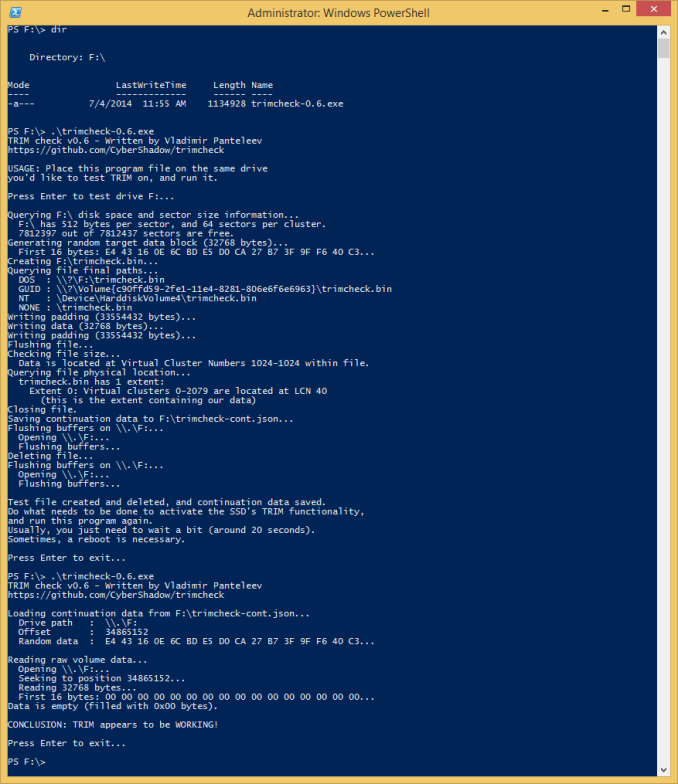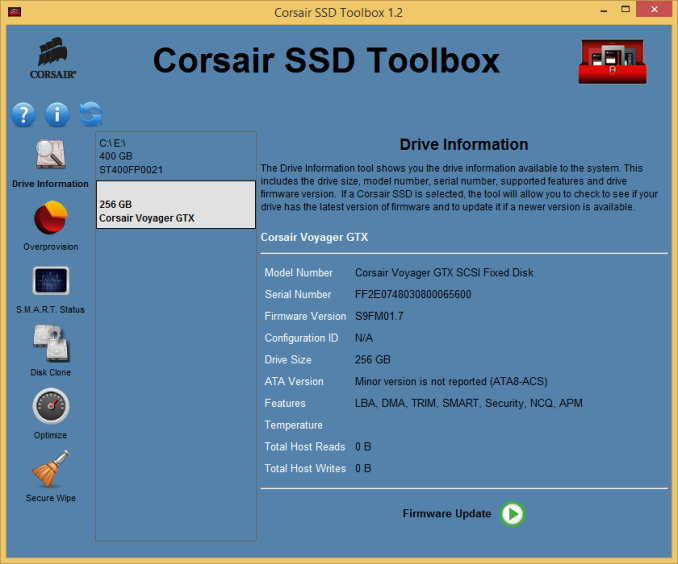Corsair Flash Voyager GTX USB 3.0 256GB Flash Drive Capsule Review
by Ganesh T S on September 24, 2014 6:00 AM EST- Posted in
- Storage
- Corsair
- USB 3.0
- Flash Drive
- Phison

The rise of USB 3.0 as a high speed interface for PCs and the increasing affordability of flash memory has led to some very interesting products. USB flash drives are a dime a dozen, but there is scope for manufacturers to differentiate themselves. Corsair's Flash Voyager GTX series brings SSD controllers to the flash drive market. Coupling it with a SATA - USB 3.0 bridge allows them to set benchmark records for their product line. More importantly, it brings some unique features. The rest of the review will present the DAS (direct-attached storage) benchmark numbers from our evaluation of the 256GB version, along with a few observations.
Benchmarking with HD Tune Pro
The unit was benchmarked in our DAS testbed (running Windows 8.1 Pro x64) after formatting it in NTFS. Prior to formatting, we ran HD Tune Pro's artificial benchmarks on the drive. Note that the sequential read / writes do not make a lot of sense for SSDs or flash drives, as they are more for determining how bandwidth varies as we go further away from the spindle in hard drives.
From the gallery above, we have around 336 MBps reads and around 178 MBps writes for random accesses. For large (8 MB) accesses, this improves to 395 MBps reads and 231 MBps writes.
TRIM Support
HD Tune Pro's information page shows that the flash drive supports all the S.M.A.R.T features as well as a multitude of other SATA features. Importantly, TRIM is supported. Using CyberShadow's TrimCheck utility, we confirmed that TRIM does indeed work on the Flash Voyager GTX.
Benchmark Numbers
Moving on to real-life benchmarks, we first have the robocopy benchmarks with various queue depths (as made visible to end users through robocopy's multi-threaded option)
| Corsair Flash Voyager GTX USB 3.0 256 GB robocopy Benchmarks (MBps) | ||||||||
| Write to DAS | Read from DAS | |||||||
| 8 | 16 | 32 | 64 | 8 | 16 | 32 | 64 | |
| Photos | 122.72 | 116.11 | 118.37 | 119.59 | 279.94 | 313.99 | 303.84 | 295.13 |
| Videos | 122.40 | 118.19 | 118.90 | 118.81 | 298.63 | 292.18 | 289.24 | 288.14 |
| BR | 117.35 | 118.09 | 114.84 | 117.06 | 297.71 | 291.59 | 289.20 | 285.51 |
The robocopy benchmarks represent the typical use-case for high-speed flash drives. However, we also processed PC Mark 8's storage bench. Out of the various available workloads, we chose a few multimedia processing traces.
| Corsair Flash Voyager GTX USB 3.0 256 GB PCMark8 Storage Benchmarks (MBps) | ||
| Write Bandwidth | Read Bandwidth | |
| Adobe Photoshop (Light) | 140.46 | 105.57 |
| Adobe Photoshop (Heavy) | 153.69 | 107.60 |
| Adobe After Effects | 123.47 | 120.05 |
| Adobe Illustrator | 138.09 | 114.13 |
Corsair SSD Toolbox
The Flash Voyager GTX is also recognized by Corsair's SSD Toolbox. One of the interesting facts revealed by the toolbox is the firmware version, S9FM01.7. A cursory search of the version number on the Internet reveals that the controller in the flash drive is the Phison S9. Readers might remember the previous generation Phison S8 controller being used in the Corsair Force Series LS SSD. It is heartening to see that the SSD controller along with the flash chips and the SATA - USB 3.0 bridge can be packed in such a small form factor.
The SSD Toolbox also allows for upgrading the firmware and configuring the overprovisioning (i.e, X GB out of 256 GB can be set aside, invisible to the OS, for use by the SSD controller to prolong the life of the flash).
Concluding Remarks
Coming to the business end of the review, the Corsair Flash Voyager GTX USB 3.0 flash drive continues Corsair's tradition of improving the performance of their USB 3.0 flash drive every year. As icing on the cake, we have a real SSD controller in the form of the Phison S9 inside.
The performance of the drive leaves us with no doubt that it would be a great Windows-to-Go drive. Unfortunately, Corsair has not decided to pursue the certification process. As far as non-enterprise consumers go, this is perfectly acceptable - the performance for Windows-to-Go is there without the extra cost associated with obtaining the certification that eventually gets passed on to them.
Minor points of concern include Corsair's refusal to divulge the flash memory configuration / SATA - USB 3.0 bridge model being used (as these could potentially change in future production runs) and the inability to configure overprovisioning for non-NTFS file systems.
Pretty much the only downside is the premium that one needs to pay for the form factor. The 256GB version currently retails for $220 on Amazon, which is at least $70 more than what one would pay for a 2.5" SSD and a bus-powered USB 3.0 enclosure. There are definitely use-cases where the form factor (and absence of hanging cables) plays an important role. In those roles, the Corsair Flash Voyager GTX is one of the top performers.


















24 Comments
View All Comments
DanNeely - Wednesday, September 24, 2014 - link
While products like this are interesting, smaller flash drives are sold at hundreds of times greater volume. A roundup doing some quick tests of a few dozen drives in the $10-30 range (and only going that high to see if spending a little more is worth it for faster performance as well as capacity) would be a lot more beneficial to readers.designerfx - Wednesday, September 24, 2014 - link
I would think the reliability of a flash drive that supports proper trim would be more important than the cheapness of the existing flash drives - once price goes down.Right now the drives are so cheap (and poor quality) that replacement is the easiest choice.
semo - Thursday, September 25, 2014 - link
If I'm reading this right, you seem to be equating TRIM support with reliability which is not the case. Based on my experience with the blue USB 3.0 Voyager drives, I wouldn't trust Corsair for reliability.The fact that they are planning on pulling a bait-and-switch with the internals of this GTX flash drive means I'll never buy a Corsair product again. Are Corsair trying to fill the void that OCZ left? I didn't know that demand for shoddy marketing practices was high.
KenPC - Wednesday, September 24, 2014 - link
Great review. I would suggest an article evaluating the leading 'high end' USB drives at about 128GB and above using the Anand pillars of SSD performance. In the race to differentiate, the suppliers are looking for the biggest performance numbers possible, that may not match real life experiences. To your point, these devices tend to be high value compared to more generic USB drive types available.mertesn - Wednesday, September 24, 2014 - link
There's also the Mushkin Ventura Ultra series. Their 240GB drive is $120 on Newegg. IIRC they've been out for at least a year. They use the SandForce 2281 controller and perform quite nicely.hojnikb - Wednesday, September 24, 2014 - link
Too bad ssd controller makers dont include usb support. That would eliminate the need for sata->usb bridge and thus saving space and cost.Araemo - Wednesday, September 24, 2014 - link
Is this a 'native' USB drive using UASP, or is this a USB-attached IDE/ATA/SCSI controller connected to a 'standard' SSD controller?Part of why I ask is how differently they're handled by some low level functions in windows. (For example, if you wanted to use this as a very fast offline media for SCCM Operating System Deployment (OSD), and it's detected as a 'hard disk'("Fixed disk", even if hot-swap enabled) rather than a 'usb flash disk'("Removable disk"), it won't work, because it gets confused by the extra hard disk detected.)
semo - Thursday, September 25, 2014 - link
Corsair have not told Anandtech what the internals are as per the article. This means that they will wait a few months before every tech site out there reviews them and then they will promptly switch to cheaper internal components without changing the product name or SKU.So even if you knew what was inside them now, may not be the case by the time you buy one.
Dustin Sklavos - Thursday, September 25, 2014 - link
That's doubtful. The controller will remain the same, we just don't divulge the flash in case we can source comparable flash elsewhere.We also learn from the mistakes of our competitors. Whenever something like what you're saying is even suggested, there's a LOT of internal resistance it has to fight through.
semo - Friday, September 26, 2014 - link
Well the firmware might change and a feature that was there before may no longer be available with the latest revision. Who knows what changes may need to be made to accommodate cheaper flash once all the reviews are in.I just don't trust companies that do a bait-and-switch on components or ones that aren't transparent about their hardware.